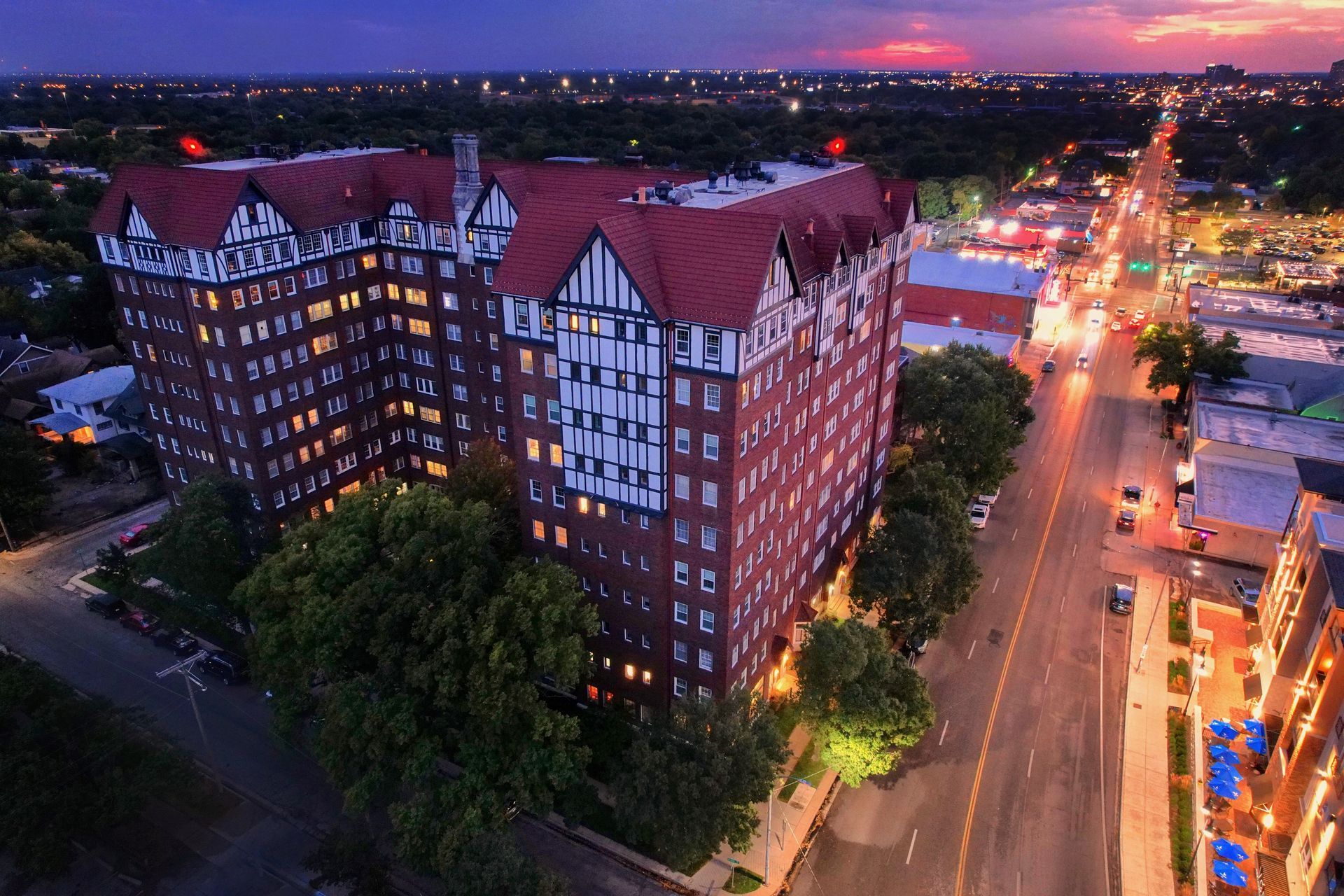Ahead of Its Time
Historic Hillcrest Apartments
Written by Joe Stumpe
Photography by Taylor Hunt
Historic Hillcrest Apartments
Written by Joe Stumpe | Photography by Taylor Hunt



Eileen Kludt
A Wichita woman was reading the Saturday Evening Post one day in the 1920s when she mentioned that the city could use a luxury high-rise apartment building like the ones in New York City and Chicago.
“That’s how the idea blossomed with her husband, and it became his dream,” said Eileen Kludt, who lives in the Hillcrest Apartments completed by Herman Hoffman and others in 1927.
Nearly a century after it opened, the Hillcrest remains a dream residence for Kludt and others charmed by its stately facade, old-school ambiance and location on the slope of College Hill. And then there are the sunset views from the tenth-floor, westward-facing sky room.
Hoffman wasn’t able to enjoy his creation for long, dying of a heart attack a year after its completion. But the ten-story building fulfilled his ambition of becoming a home to the kind of folks who appeared in social columns of the Wichita Eagle and Beacon. An early newspaper advertisement for it depicted a family relaxing in their living room while a maid toiled in the kitchen. A governor, congressman and scores of prominent residents have called it home.
Today, the live-in maids are gone, their quarters converted to home offices or extra bedrooms, and a ballroom on the top floor has been converted to apartments. But residents can still relax in a parlor off the main entrance that looks much like it did when male residents gathered there to smoke cigars (don’t worry, any trace of smoke is long gone). Back then, the women had a separate lounge in which to socialize (also now converted to an apartment).
The Hillcrest was the state’s tallest building when it opened. The Eagle and Beacon covered its development in detail, starting in 1925 when Hoffman successfully petitioned the city to rezone the former site of an osteopathic hospital at the southwest corner of Douglas and Rutan for an apartment building. Hoffman paid $30,000 for the property, trading a 10-acre chicken ranch in Riverside as part of the deal.
The next year, Hoffman incorporated the Douglas-Rutan Building Co. with architect Lorentz Schmidt and other partners. Hoffman also purchased another 100 feet of frontage on Douglas for a parking garage.
The H-shaped apartment building, designed by Schmidt’s firm, was projected to cost $1.2 million and contain 88 apartments ranging in size from two to six rooms. It now holds 97 units ranging in size from 700 to 1,700 square feet.
According to the website of the Society of Architectural Historians, the Hillcrest followed the same Tudor revival style as some surrounding residences: “a picturesque combination of rough brick and stucco decorated with half-timbering … Tudor elements were used in a more inventive way at the top of the building, where an array of gabled, half-timbered forms project from the building’s brick mass, as if a medieval English village had landed atop the structure.”
The website says the building has changed little, a credit to the quality of its construction and its cooperative ownership structure. Residents own their units, pay a monthly fee that covers operations of the building such as maintenance, utilities and taxes, and elect a five-member board to oversee it.
The parking garage — the first in the state with ramps — originally held a small filling station. Non-residents could park in it for 25 cents per day. There have always been a handful of small businesses and offices on the first floor, accessible by a separate entrance.
The inspiration for the building — Hoffman’s wife, Lottie — served as its first manager. She died in 1970.
Today, residents range from families with small children to senior citizens, with somewhat more of the latter. Some units have been passed down through generations. Kludt, who moved to the Hillcrest four years ago, notes that residents are free to modify the interior of their apartments as they see fit. “Once you go in, you see every style you can imagine, from very modern to apartments that look like you’re walking back into the ’20s and ’30s,” she said.
Kludt’s grandchildren think she lives in a hotel, and have asked where the pool is (the building doesn’t have one, although it originally had a children’s playground). Residents have a book club and crocheting group, and there’s a book exchange library and game room in the basement next to the laundry. Kludt loves amenities like the valet parking and doorman who will carry groceries to residents’ apartments, and little touches on the building like a decoratively carved drainpipe outside and stained-glass window in the parlor.
A gardening enthusiast, Kludt admits she originally wasn’t keen on giving up her yard to live in the Hillcrest. Now she gives talks about it to local groups.
“It was ahead of its time,” she said. “It became the place where things happened in Wichita. I could go on for days.”
SUBSCRIBE TO SPLURGE!
Thank you forsubscribing to Splurge! Magazine
Please try again later.
ADVERTISE WITH SPLURGE!
Send us your contact information & we’ll schedule an appointment with you as soon as possible!
